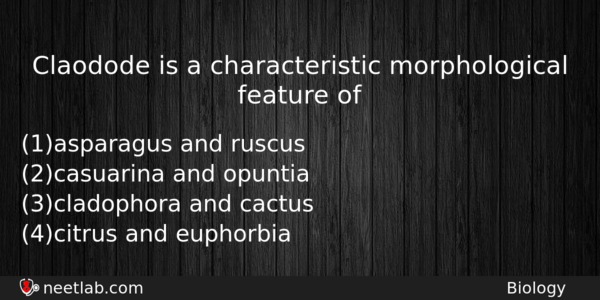| ⇦ | 
| ⇨ |
Claodode is a characteristic morphological feature of
Options
(a) asparagus and ruscus
(b) casuarina and opuntia
(c) cladophora and cactus
(d) citrus and euphorbia
Correct Answer:
asparagus and ruscus
Explanation:
It is a modification of the stem the branch of the single internode gets flattened and becomes a leaf like structure. The actual leaves get reduced to scales. From the axils of the scales develops a group of linear acicular structure these are known as cladode. Example: Asparagus, Ruscus.
Related Questions: - Lenticels help in gaseouss exchange and lenticular transpiration
- A femur is kept in dilute HCI for three days it becomes
- A population will not exist in Hardy -Weinberg equilibrium if :
- Erythropoesis may be stimulated by the deficiency of
- Ecoli in human colon behave as
Question Type: Memory
(964)
Difficulty Level: Easy
(1008)
Topics: Structural Organisation In Plants
(243)
Subject: Biology
(4253)
Important MCQs Based on Medical Entrance Examinations To Improve Your NEET Score
- Lenticels help in gaseouss exchange and lenticular transpiration
- A femur is kept in dilute HCI for three days it becomes
- A population will not exist in Hardy -Weinberg equilibrium if :
- Erythropoesis may be stimulated by the deficiency of
- Ecoli in human colon behave as
Question Type: Memory (964)
Difficulty Level: Easy (1008)
Topics: Structural Organisation In Plants (243)
Subject: Biology (4253)
Important MCQs Based on Medical Entrance Examinations To Improve Your NEET Score
18000+ students are using NEETLab to improve their score. What about you?
Solve Previous Year MCQs, Mock Tests, Topicwise Practice Tests, Identify Weak Topics, Formula Flash cards and much more is available in NEETLab Android App to improve your NEET score.
Share this page with your friends

Leave a Reply